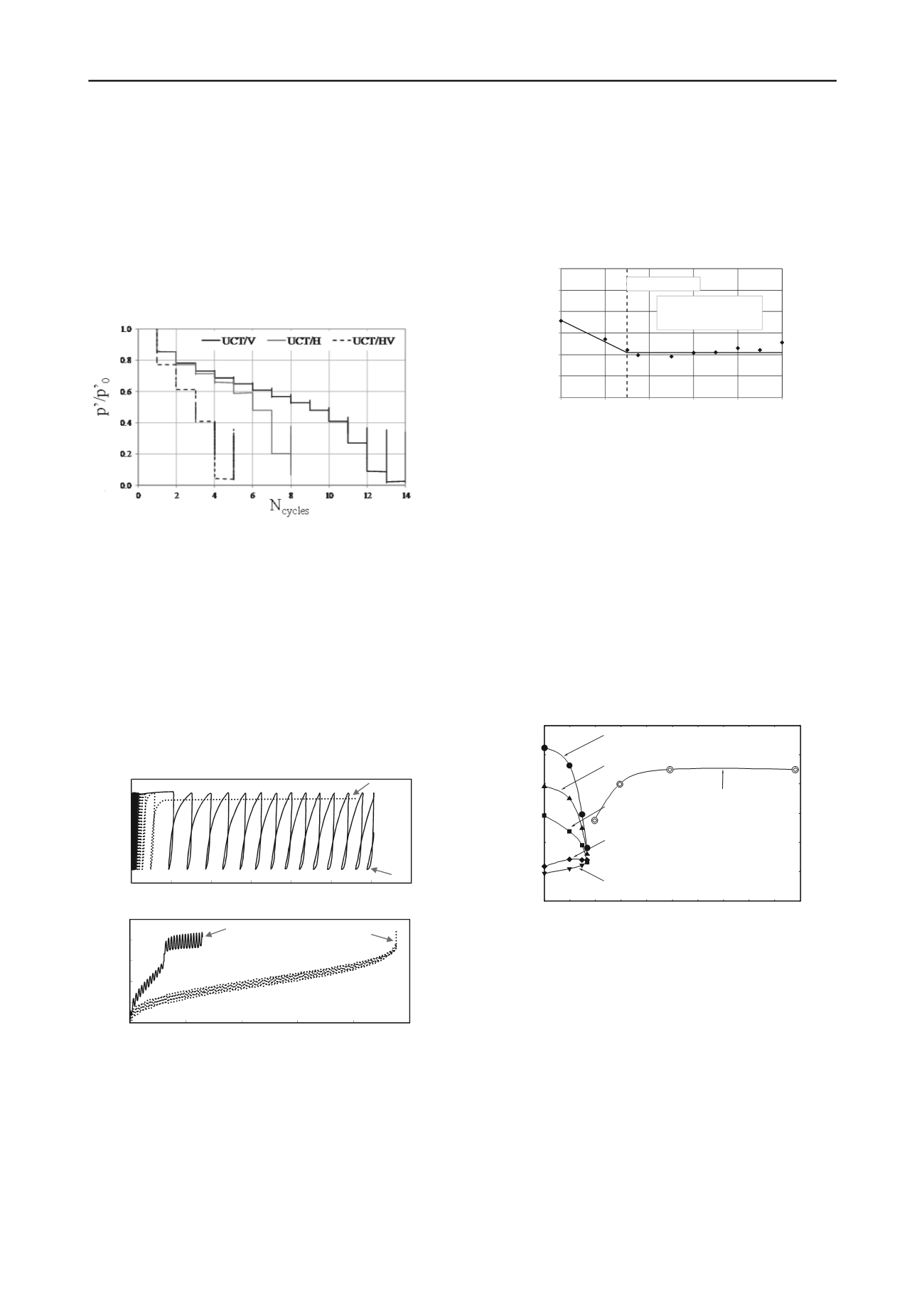
1401
Technical Committee 203 /
Comité technique 203
UK), in their ‘Challenges to the laboratory evaluation of field
liquefaction resistance’. Air-pluviated specimens of uniform
Coimbra sand were saturated, isotropically consolidated at the
same effective stress, and subjected to undrained CTX tests with
different loading patterns. Irregular axial loads including a
singular higher amplitude cycle pointed out the significant
influence of its location, in terms of current mean effective
stress ratio, p’/p’
0
, on the number of cycles for the onset of
liquefaction. Cyclic strength was greater under axial (UCT/V)
than under radial (UCT/H) loading; also, multidirectional load
patterns (UCT/HV) led to an even faster degradation than that
observed in the unidirectional tests (Fig. 6).
Figure 6. Comparison between liquefaction resistance under
unidirectional and multidirectional loading (
Coelho et al.
).
Sze & Yang
(Hong Kong) studied the ‘Cyclic loading
behavior of saturated sand with different fabrics’ by comparing
the failure modes of moist tamped (MT) and dry deposited (DD)
loose specimens of uniform Toyoura sand. Undrained CTX tests
were driven with different static shear stress ratio,
, showing
different failure modes, varying from ‘cyclic mobility’ to
‘limited’ or ‘runaway’ deformation (Fig. 7). The mechanisms
are viewed as dependent on both inherent anisotropy (expected
to be higher for DD specimens) and the stress-induced fabric
changes, in turn controlled by the combination between
and
the cyclic stress ratio, CSR=q
cyc
/(
1c
+
3c
). The Authors
conclude that fabric effects might be very significant, although
they are inherently not accounted for in conventional design
procedures, such as those based on liquefaction charts.
-50
0
50
100
150
200
250
0
2
4
6
8
10
12
1
Deviatoric stress (kPa)
Axial strain (%)
MT
DD
4
0
100
200
300
400
500
0
20
40
60
80
1
Excess PWP (kPa)
Loading cycles
MT
DD
00
Figure 7. Limited (DD) vs. runaway (MT) deformation for
=0.1,
CSR=0.11 (
Sze & Yang
).
3.2
Silty sands
Mominul et al.
(Bangladesh) investigate on ‘Dynamic properties
and liquefaction potential of a sandy soil containing silt’ by
means of undrained CTX tests on wet tamped specimens of
dense silty sand. Results are reported in terms of strain
dependent modulus and damping (indeed, well beyond the
linear threshold strain), and cyclic resistance curves relevant to
both pore pressure ratio and strain amplitude criteria are
compared. The ‘cyclic resistance ratio’ (i.e. CRR) was defined
as the CSR value required to reach 5% double amplitude axial
strain in 20 cycles: it was seen to decrease with non-plastic silt
content increasing up to 30%, and to be nearly constant above
this value (Fig. 8). It must be recalled that conventional
empirical methods imply increasing the cyclic resistance ratio
when plastic fines are present, but no correction for non-plastic
fines is normally implemented.
0.00
0.05
0.10
0.15
0.20
0.25
0.30
0
20
40
60
80
1
Cyclic StrengthRatio
LimitingFineContent
00
Silt Content (%)
AxialStrain±3%,at 20Cycles
Effectivestress=100
kPa,Dr=60%,
f =
1Hz
n of cyclic strength ratio with non-plastic silt content
(
M
if a properly
defined ‘equivalent granular void ratio’ is adopted.
Figure 8. Variatio
ominul et al.
).
Noda & Hyodo
(Japan) also investigate on ‘Effects of fines
content on cyclic shear characteristics of sand-clay mixtures’ by
mixing silica sand with a medium plasticity clay in different
proportions, spanning from clean sand to clayey silt. By
comparing undrained CTX tests on specimens compacted with
different energy, it was again observed that the cyclic resistance
ratio decreased with fines content, F
C
, up to about 20% for
dense mixtures, while the opposite trend was shown by the
loose ones (Fig. 9). Specimens with plastic F
C
>20% had to be
prepared by slurry pre-consolidation: they showed a rapid
increase of the cyclic resistance ratio up to F
C
=50%, beyond
which the liquefaction strength asymptotically approached that
of the clayey silt. Finally, the Authors interestingly suggest that
with non-plastic F
C
<20%, the dependency of cyclic resistance
ratio on F
C
at a given relative density is scaled out,
0 10 20 30 40 50 60 70 80 90 100
0.05
0.10
0.15
0.20
0.25
0.30
0.35
Cyclic deviator stress ratio, R
L(N=20)
E
c
=504kJ/m
3
E
c
=324kJ/m
3
E
c
=113kJ/m
3
E
c
=51kJ/m
3
E
c
=22kJ/m
3
Fines content, Fc(%)
Pre-consolidation
method(
σ
v
=50kPa)
n-plastic (F
C
<20%)
and plastic (F >20%) silt content (
Noda & Hyodo
).
th confining
pressure, apparently due to interlocking soil fabric.
Figure 9. Variation of cyclic resistance ratio with no
C
3.3
Peculiar soils
Elmamlouk et al.
(Egypt) analyze the ‘Liquefaction
susceptibility of loose calcareous sand of Northern Coast in
Egypt’ by means of undrained CTX tests on a poorly graded
calcite-sand with apparently non-plastic fines content lower
than 10%. Reconstituted specimens were prepared by tamping,
appropriately using undercompaction technique (Ladd, 1978) to
reach the target relative density D
r
=40% after consolidation.
This calcareous sand showed greater cyclic strength (in terms of
pore pressure ratio r
u
=1.0) compared to siliceous sands at the
same D
r
and
c
(Fig. 10). Particle crushing under cyclic loading
was found to be insignificant for the range of σ′
c
applied,
resulting into a cyclic resistance ratio decreasing wi


